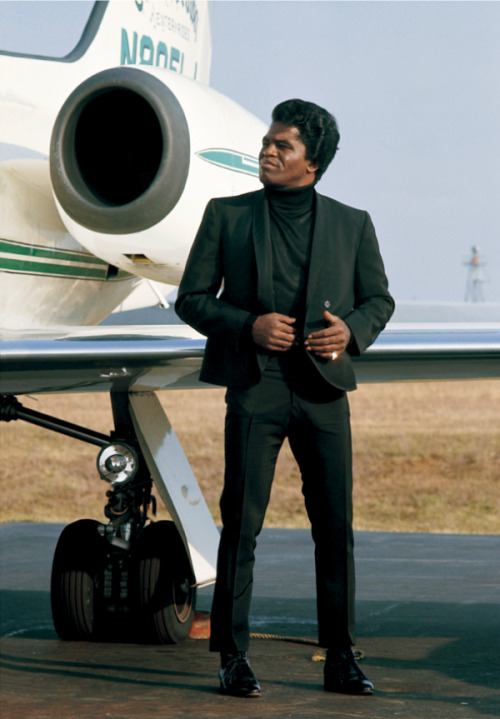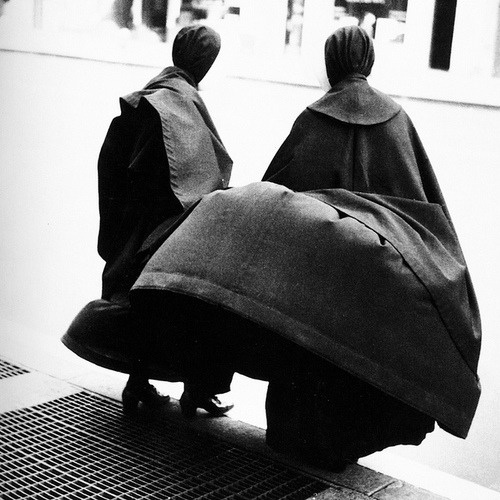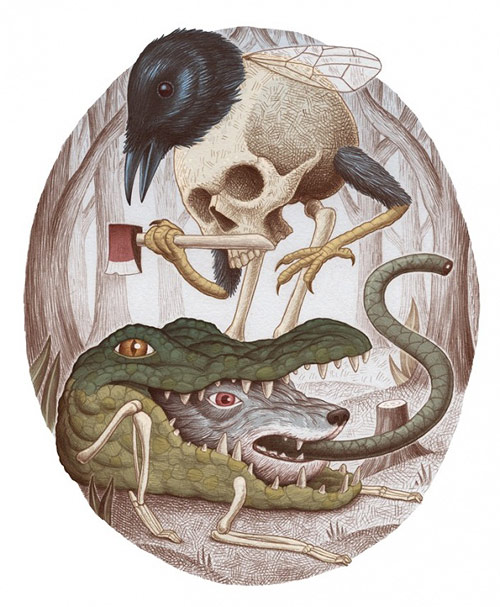
Marsorbis
Shared posts
Meet Ancient Peru's own Grumpy Cat
Grumpy Cat, Shocked Cat, Lil Bub – their images are the currency of the web, passed between friends, family, and co-workers. When they go viral, funny cat pictures heal daily drudgery with a dose of furry, cuddly cheer. But, in terms of the reverence they receive, these cats are hardly the first of their kind. Ancient cultures had cat memes too, and archaeologists have their own term for them: feline motifs.
The word meme, itself a meme, feels ultra-modern, but was coined in the 1970s by Richard Dawkins to refer to any non-genetic unit of replicated information. And it would be chronocentric to presume this term applied only to the proverbial Caturdays following its contemporary articulation. Some archaeologists, known as evolutionary archaeologists, incorporate memetics into their explanations of cultural transmission and change. In their view, cultural evolution, or the speciation of different cultures, happens by selective forces acting on cultural memes, motifs and styles.
We can look back about two thousand years and see cat memes on objects made in the Americas before Columbus set boot here. In fact, the feline motif is a powerful point of acccess to Pre-Columbian cultures, as it was a common from the Mississippi to the tip of South America.
MEET OLD GRUMPY CAT
Take a dour little kitty artifact that resides in the American Museum of Natural History. He is Grumpy Cat’s distant cousin. Let’s call him Old Grumpy Cat, or OGC. Museum officials call him a ceramic bottle, and say he probably came from Northern Peru. Created about 2,000 years ago, he was likely used for special ceremonies, then part of a burial. Centuries later, he was dug up by grave looters and sold to collectors, ultimately making his way to his museum home and an afterlife of staring at the world from behind glass.
The vessel was not excavated by academics, so we don’t know exactly where, or when, he is from. Since soil accumulates in layers year after year, archaeologists usually determine age of objects that can’t be carbon-dated by their relation to other objects within the same depositional. No such luck with Old Grumpy.
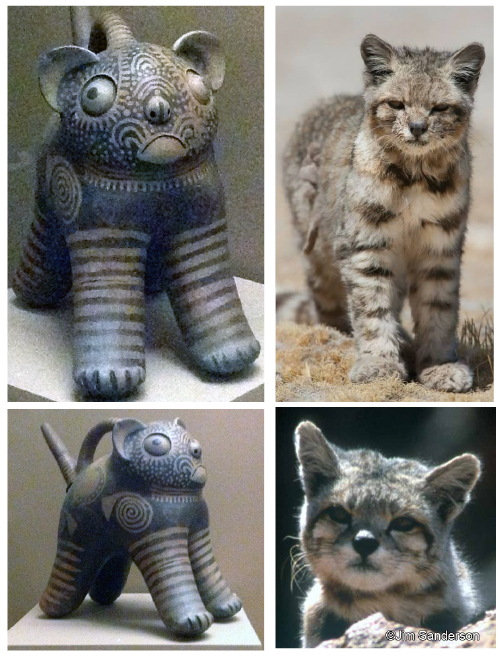
LEFT: Old Grumpy Cat at the American Museum of Natural History. Photo: Kevin Wiley. RIGHT: Andean cats. (TOP RIGHT: Antonio Nuñez-Lemos / BOTTOM RIGHT: Jim Sanderson)
Knowing what species is represented could offer a critical clue, but Old Grumpy is ambiguous. This line of thought, however, can still lead to useful insights.
For example, wild cat conservationists in South America point out that historically-rooted feline reverence makes cat-hunting less likely, helping preserving the ecosystems they inhabit. Even if not sacred per se, cats can be symbols of the regions they inhabit, a source of pride, which, conservationist argue, can save cats’ lives.
Archaeology can also provide data for biologists, as in a recent case in Mediterranean fish biology. Conservationists identified groupers, a species now endangered in the area, in pre-Christian mosaic art. This allowed estimates of the size of ancient groupers and their historic ranges, thus putting an endangered species into a bigger timeline.
SO, WHERE IZ I FROM?
Archaeologists like to group cultures by their ceramics. In Northern Peru, steep mountain ranges abut Pacific beaches. Ancient peoples thrived along rivers that run perpendicular to this coastline. Coastal cultures rose and fell in these valleys over thousands of years, each with a signature style of pottery.
Nearly a dozen archaeologists that I spoke with agreed that the color and pattern of Old Grumpy Cat suggest the Virú river valley in Northern Peru.
OGC’s creators used a technique called resist glazing, in which wax was pressed onto a fired pot to make a design. It was then dipped into liquid glaze, which could not adhere to the waxed areas. When the pot was fired, the glaze became glassy and the wax melted away, leaving behind the design. Archaeologists most often attribute resist style to a group that inhabited the Virú valley between 500BC and 1000AD; however, there is ambiguity. On the North coast, resist style was also used by a slightly earlier culture called the Salinar, the later cultures of Chavín and Moche, as well as a culture up the coast called Vicús.
Beyond this decorative style, the people of the Virú valley are known also to have used small, not so fierce looking feline motifs in their ceramics. OGC represents a small spotted cat with striped front legs. This motif had wide currency in the region, as it is also found far to south in petroglyphs associated with the Wari people.
The feline meme evolved, and the time of the Inca (about 1400AD), the most commonly depicted cat was a jaguar, whose meme was so stylized it could be represented by its fangs alone. Some archaeologists propose that meditation on the jaguar meme became a shamanistic ritual, in which ceramic bottles held corn beer called chicha: OGC’s little tail is actually a drinking spout.
SPEESHEEZ, PLEEZ?
Old Grumpy Cat was probably not meant to be a realistic portrait. Even 2,000 years ago, it’s unlikely there were cats with spiral spots. There were no housecats (domesticated Felis sylvestris) in the Americas then, but there were small wild cats. Was Old Grumpy Cat meant to depict one in particular?
There are now ten species of wild cat in South America, eight found in Peru. Each species can look a little different depending on age and location. So, although he doesn’t look much like an adult jaguar (Panthera onca), for example, OGC could be a jaguar kitten. Or a puma (Felis concolor), an ocelot (Leopardus pardalis), or even a margay (Leopardus weidii).
However, the striping on his front legs of suggests one of two species in particular.
The Andean mountain cat (aka Leopardus jacobita) is the rarest small wild cat in the world, and the only endangered wild cat in the Americas, according to the International Union for Conservation of Nature. If Old Grumpy Cat was modeled on this species, he might now have good reason to be frowning. The very existence of living L. jacobita was only confirmed in the past 20 or so years, and its high and dry mountain habitat is very rapidly disappearing as climate change melts the glaciers of the Andes.
DNA evidence confirms modern Andean cat scat about 200km south of the Virú valley, near the scene of the meme.
The other possible species is the Andean cat’s cousin, the Pampas cat (aka Leopardus colocolo). Pampas’ appearance is more variable than the Andean cat, but at the Northernmost reaches of their range Pampas cats tend to have striped legs and tails, with some spots on the back, just like OGC. Indeed, biologists often use genetic tools to definitively distinguish between Andean and Pampas cats, by analyzing DNA that is sloughed off from the cats’ intestines into their droppings.
Even if their historic ecological range brought them near the Virú valley, could the makers of Old Grumpy cat have distinguished Andean cats from Pampas cats by eye?
Besides the handful of biologists who have seen them in the wild, local herders and villagers in the Andean mountains know the difference.
From 1998 to 1999 and 2001 to 2002, a conservation study in Bolivia quizzed mountain residents with photos of the two cats. They lump all small wild cats together into a group they call “titi,” but researchers found that about 18 percent of people considered there to be two different kinds of titi. Moreover, they had different names for the two titis, and described them as living in different habitats with distinct mannerisms.
The Pampas cat was called gato chaskoso, or scruffy cat, while the Andean cat was called gato sonso, or silly cat. The rare sighting of either cat is considered to bring good fortune, but seeing scruffy cat is good luck in general while silly cat brings a good harvest and protects livestock. In fact, according to researchers, locals believe that accidentally killing a silly cat creates a debt to nature that must be atoned annually, and the stuffed pelt is decorated with streamers and kept as household talisman. This modern cat reverence tracks with archaeological hypothesis about the roots of cat worship. Ancient farmers observed that small wild cats killed rodents that would otherwise eat up their crops. Cat health and well-being was a concern of these early agricultural societies.
I IZ WHAT I IZ.
Taxonomy is a way of charting relationships between things. It is a modern and scientific way of seeing the world. In terms of the lumping and splitting of ancient cultures or modern cat species, descendants of Andean cultures might have another perspective. When asked what species OGC is, archaeologist Nick Saunders points out that the Western urge for taxonomy is not always in sync with indigenous reality.
In ancient, and modern, Andean cultures, “either a one-for-one identification is inappropriate, or different features of different felines (and/or other animals) are recombined in ways which made eminent sense to their creators but totally confuse us,” he wrote.
For example, jaguar spots could be painted on a depiction of another animal, to endow that animal with jaguar powers.
Taxonomy means saying an object or animal is THIS and NOT THAT. In modern Andean cultures, there’s evidence of a less binary way of thinking. The Aymara language (spoken by about two million people throughout Peru and Bolivia) conceptualizes time with the future behind and the past is laid out in front of a person, analogous to being a passenger in a rear-facing train seat. Speakers point to their back when gesturing about future events, and forward when describing the past.
Aymara also uses a three-part, or ternary, logic system. In addition to TRUE and FALSE there is a third, equally valid option, meaning something similar to "not enough information." This has also been called Andean logic. Ternary logic systems can be really useful in describing the universe, be it the universe of perception or a set of data: consider the NULL state, used in databases to distinguish an entry that does not exist from one that represents nothing.
It is only fitting, then, that Old Grumpy Cat defies categorization. He pops out of his museum case, suddenly seeming more relevant because of his resemblance to Grumpy Cat. Maybe he has something to say about climate change effects on wild cats of the Andes, or maybe he tells of sophisticated and underappreciated indigenous people of the Americas, both ancient and modern. Maybe the spiral on the side of Old Grumpy Cat represents time, and overlap of culture and generations in the same physical space. If we assume time will continue into the future (whether we envision that as in front or behind us), perhaps future archeologists will find a Grumpy Cat coffee mug 2,000 years from now and wonder about us. 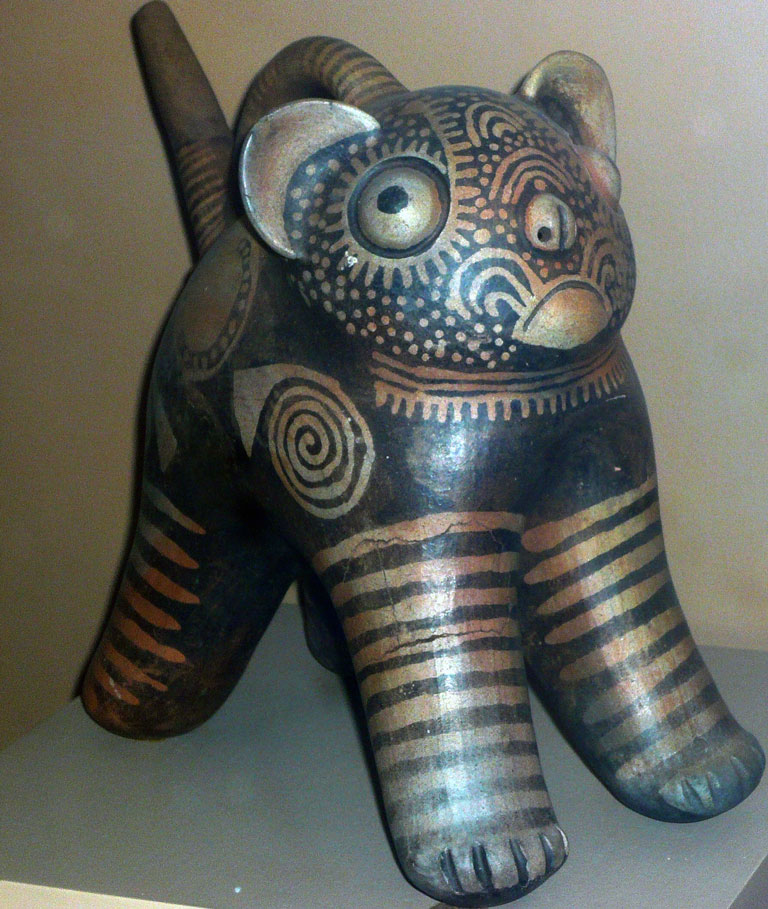
![]()
A DIY, Digital Replica Of A Vintage Camera That Is Made Of Wood

French hobbyist photographer Cesar Sehouhian—with the help of his father—has managed to DIY a digital replica of the classic Nikon F2 SLR from 1971.
Referred to as the “F2D” by PetaPixel, the remarkable thing about this replica is that it is beautifully crafted out of wood—technically, it is a wooden shell that holds a Nikon point-and-shoot camera.
Impressively, the user will be able to access some of the controls of the “inner camera” with buttons found on the wooden shell—for instance, the viewfinder lock button on the front is actually used to on and off the camera.
As the compact camera on the inside of the wooden body has a touchscreen interface, there is little need to access the physical controls on it.
For a “just for fun” exercise, this is pretty cool—see more pictures of it below.






[via PetaPixel]
CUBE BRACELET - The Clocksmiths Mood
Blow-Up this isn't happiness.™ Peter Nidzgorski, tumblr
Figurative Paintings by Christine Comyn
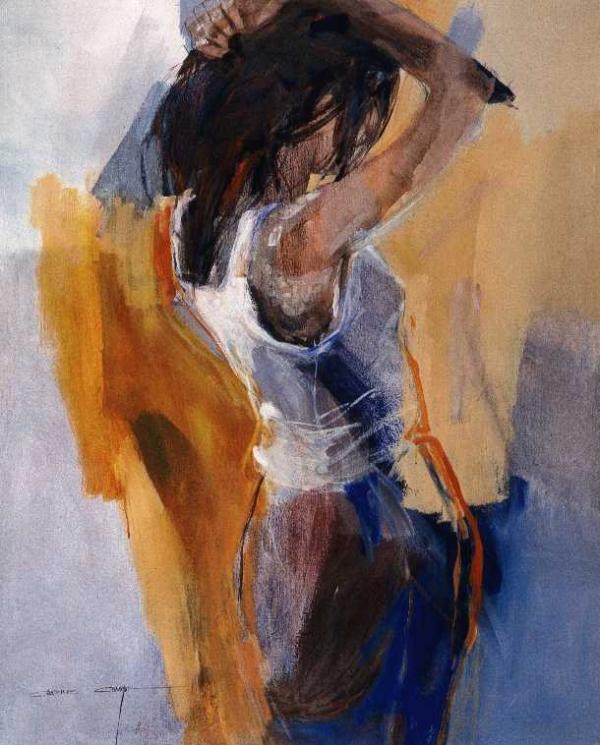
Born in Tielt, Belgium in 1957, Christine Comyn demonstrated talent for painting and drawing at a very young age. She studied at the St. Luke Academy in Ghent, Belgium, and later on at the Pedagogic Institute for Promotion, also in Ghent with the intention of becoming an educator.
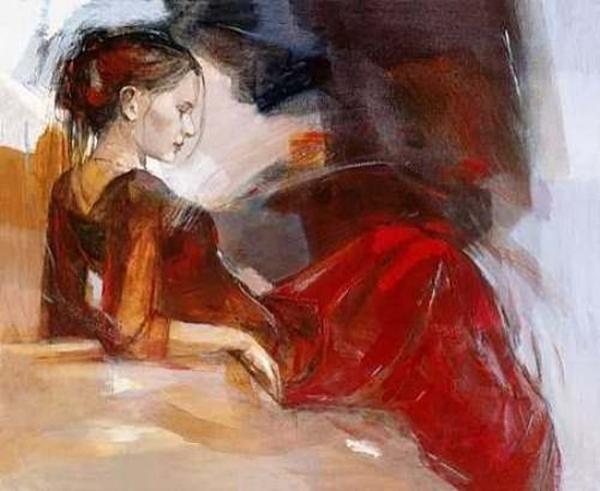
‘Resume Baker’ Custom Resume Design Giveaway: Make Youre Resume Stand Out!
li hui
.
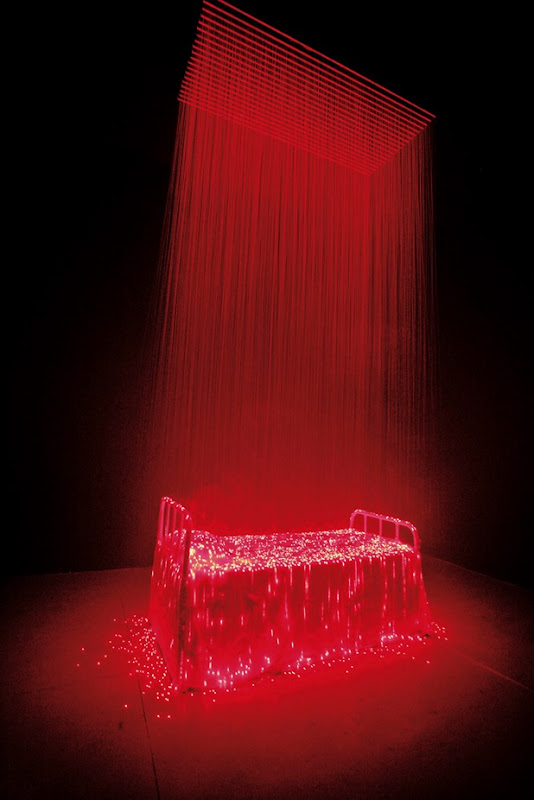
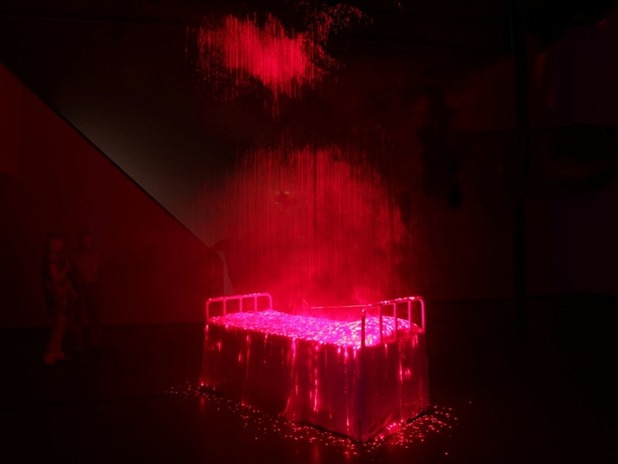


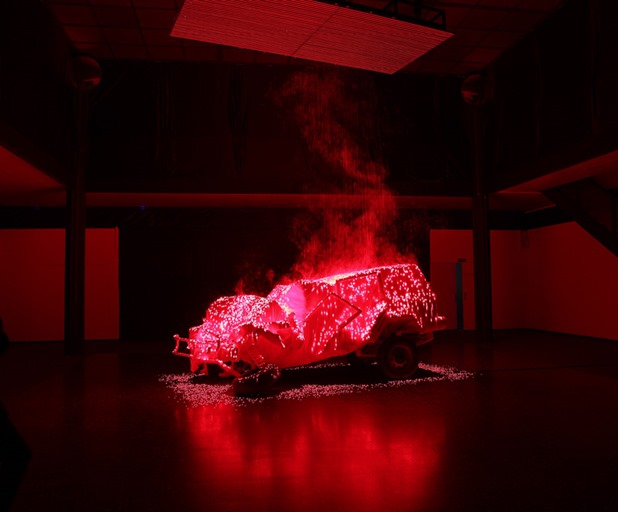
light installations by li hui
.
The “paradox” is only a conflict between reality and your feeling... - but does it float
Poster Ads ‘Hide’ Flags of Other Countries In US and UK Flags

To advertise for ACCEM, an NGO which gives aid to refugees and immigrants, the ad agency Draftfcb has come up with a series of visually intriguing posters.
The main focus of these posters show the flags of the US and UK, but the flags of other countries are strategically hidden within the poster, driving the message of integration home.
By almost seamlessly blending the flags together, these posters are effective as they embody the tagline, “Integrating refugees, keeping identities.”
View the other poster design below.

[via I Believe In Advertising]
esse: Dictionary.com Word of the Day
JFK’s New England Fish Chowder.
Going through the John F. Kennedy archives I came across this recipe for New England Fish Chowder. Apparently, chowder was the favorite dish of JFK —pictured here sailing on the Presidential yacht Manitou near Hyannis Port, Mass. which was one of his favorite activities.
Could this be the beginning of an archival food section for ACL? Unlikely. But nevertheless it’s an amusing little piece of history. Someone please follow this recipe and report back.
Images via the John F. Kennedy Library, Boston, MA.
A Website Devoted To Redesigning Covers of Classic Literary Works

With everything going digital, it’s hard to find people who still read the classics, although The Creative Action Network and Daily Lit are all set to change that.
By crowdsourcing designers to redesign the covers of 50 classic titles, these books may attract readers and be enjoyed once again.
Each book can be purchased in both their softcover and digital incarnations on the website Recovering The Classics, with proceeds going to the designers.
Scroll down to view these appealing, redesigned covers of well-known literary classics.












[via Recovering The Classics]
The Difference Between ‘Porn Sex’ And ‘Real Sex’, Explained With Food

New York City-based production company KB Creative Lab has created a viral video that might just “whet your appetite”.
Titled ‘Porn Sex vs Real Sex’, the video uses fruits, vegetables and other types of food to humorously explain the differences between real-life sex and the sex found in pornography.
Click to watch the video below:











[via Laughing Squid]
How Much Does It Cost To Be A Superhero?

It’s a tough life being a superhero, what with all the late sleepless nights, juggling work and fighting a constant stream of baddies.
And that’s not even accounting for the substantial cost that goes into crime fighting today. It’s not so bad if you happen to be a billionaire playboy industrialist, but it must be hard if you’re still a student or can’t hold down a steady job because of anger management issues.
It was probably easier being a superhero back in the good old days when everything was cheaper. But how much cheaper was it back then?
These infographics, created by Emil Lendof, Bob Al-Greene and Nina Frazier for Mashable, explores the annual cost of being a superhero in real life, comparing the prices between then and now (taking inflation into account).




[via Emil Lendof]
Lively Typographic Posters Evoke Video Game Nostalgia

A native of Minnesota, Jay Roeder has a penchant for drawing and it shows.
In this series of illustrations, Roeder reminds us of what it was like to play video games in the old days, with a Game Boy or Super Nintendo Sega Genesis in tow.
Our favorite poster is the one which reminisces about blowing off on the Nintendo game cartridge to get it to work.
Which one is your favorite?
View the rest of these prints below.









[via Jay Roeder]
Courtly Cats Painted As Classical Oil Paintings

Takshent, Uzbeskitan-based illustrator Eldar Zakirov has created a series of courtly cat paintings for Russian magazine Hermitage.
Although stylized as highly-realistic looking oil paintings, the portraits are actually digitally created.
Garbed in formal, court attire, the Zakirov’s cats manage to impose an air of regality, no doubt helped by their confident nature.
The Hermitage Court Outrunner Cat

The Hermitage Court Moor Cat In Casual Uniform

The Hermitage Court Moor Cat

The Hermitage Court Confectioner Apprentice Cat

The Hermitage Court Waiter Cat

[via My Modern Met]
Nick Sheehy
Drawings by Nick Sheehy. England. See more below!
View the whole post: Nick Sheehy over on BOOOOOOOM!.
















